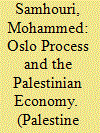|
|
|
Sort Order |
|
|
|
Items / Page
|
|
|
|
|
|
|
| Srl | Item |
| 1 |
ID:
154307


|
|
|
|
|
| Summary/Abstract |
Since the military occupation of the West Bank, East Jerusalem and the Gaza Strip (WBGS) in June 1967, the Palestinian economy has been tightly linked to Israel in an involuntary relationship that can best be characterized as asymmetric in all its aspects. Given the wide economic and developmental gap between the two sides, and according to the basic precepts of neoclassical trade theory, such a relationship was supposed to benefit the less fortunate Palestinian economy more than the more developed and advanced Israeli economy. Over time, the theory predicted a sustained convergence between the two economies should be realized, and the income gap subsequently narrowed. That, however, did not happen, and the economic gap that separates Israel and the occupied Palestinian territories (OPT) continued to grow steadily.1 In 1968, for example, while GDP per capita in Israel (at $1,674) was 10 times higher than that of WBGS, the gap became wider in 2015, with Israeli per capita income (at $35,728) more than 12 times higher than the Palestinian one (at $2,866).2 The absolute gap in GDP per capita between the two economies, however, is much more revealing. While the difference in GDP per capita between Israel and the WBGS was only $1,500 in 1968, the absolute difference jumped to close to $33,000 in 2015. Put differently, while GDP per capita in WBGS increased by only $2,700 over the entire five-decade period, Israel’s GDP per capita increased by more than $34,000 over the same period.
|
|
|
|
|
|
|
|
|
|
|
|
|
|
|
|
| 2 |
ID:
161221


|
|
|
| 3 |
ID:
148181


|
|
|
|
|
| Summary/Abstract |
The 1994 Paris Protocol on Economic Relations between Israel and the Palestine Liberation Organization (PLO) supposedly aimed to achieve two objectives: to enhance the parties' interest in peace and to strengthen the Palestinian economy. Twenty years after, neither of these goals were realized. If anything, the prospects of achieving them worsened over time. This study argues that the protocol's failure was largely due to the overall political and territorial context within which it was implemented. This context was so restrictive and damaging for the Palestinian side that any alternative economic arrangement which could have been negotiated between the parties in 1994 would have been equally incapable of delivering a different outcome.
|
|
|
|
|
|
|
|
|
|
|
|
|
|
|
|
|
|
|
|
|